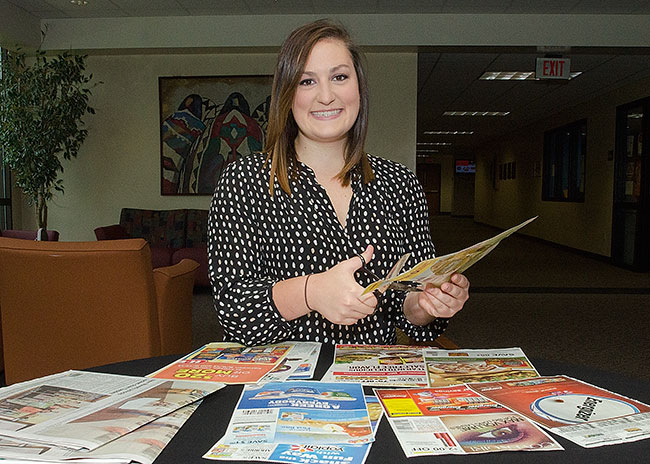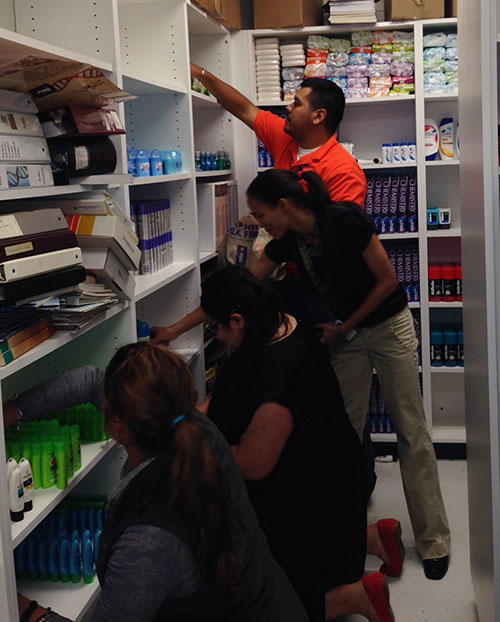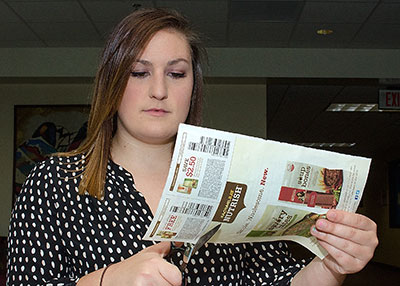Future Teachers Leave A Legacy Through ACE Class Project
May 20, 2014
SHSU Media Contact: Jennifer Gauntt
Story By: Amy Barnett
 |
| Hillary O'Grady utilized her family tradition of "extreme couponing" for the benefit of students at Madisonville High School. For the "Legacy Project," part of Lisa Brown's methods block classes, O'Grady and her peers collected more than $450 worth of hygiene products for only $15 to fulfill the school's student need. —Photos by Brian Blalock |
“I come from a big, hillbilly family,” laughed Hillary O’Grady. “We’re not ashamed to ask for help or save a few bucks and we love buying off-brand stuff.”
O’Grady, a theatre education major at Sam Houston State University, reflects on a project that allowed what she learned during her frugal upbringing to take center stage and, as a May graduate, to leave behind a “legacy.”
“When I was younger I thought life was good and we didn’t suffer at all, but I didn’t realize how poor we were or how my mom struggled as a single mother with three children,” said O’Grady. “My siblings remind me that we ate beans and rice or weenies and bread every night; but I liked that food, so I had no idea how hard my mom worked to try to give us the best life she could.”
O’Grady doesn’t remember the suffering her family went through when she was younger, but she saw it in the eyes of many students at Madisonville High School, where she spent an entire semester observing and teaching as part of the traditional methods block of classes for education majors.
Education majors take methods classes during the semester prior to their student teaching. The block of classes includes the Academic Community Engagement curriculum, which involves a teaching method that combines community engagement with academic instruction.
Spearheaded by former Provost David Payne, the ACE initiative allows students to use skills and knowledge learned in the classroom to make a difference and improve life in the community by understanding their roles as community members.
“Our students had class in Madisonville, where they were in a classroom with us for half the day and then practiced in their mentor’s class the other half,” said Lisa Brown, assistant professor of education.
As part of the class curriculum, O’Grady and her fellow classmates were instructed to spend at least 10 hours on a project that would allow them to “leave something behind ” at Madisonville High School to make life better for students.
“We spoke with some of the teachers and the principal and learned that nearly 75 percent of the kids in the school are economically disadvantaged,” said O’Grady. “And we learned that a lot of their families didn’t have enough money to buy hygiene products.”
 |
| College of Education students stock the supply closet at Madisonville High School with the hygiene products they purchased for the "Legacy Project." SHSU's students chose this project because nearly 75 percent of MHS students coming from economically disadvantaged backgrounds; they understand that students who aren't clean can be bullied and have low self-esteem. —Submitted photo |
A handful of students at Madisonville High School also live in homes without running water, according to principal Shaye Murphy.
Realizing that a lack of hygiene supplies and the ability to keep themselves clean can cause students to be bullied and have low self-esteem, O’Grady’s group—which included Jessica Griffin, Liz Evans, Stephanie Gomez and Jose’ Garcia—decided to take on the challenge of filling some of that need; and O’Grady knew just where to start—in a paper dumpster.
“I thought ‘oh my gosh, the best way to do this is with extreme couponing,’” said OGrady.
It’s something her family has been doing for several years, just like you may have seen on the reality television show “Extreme Couponing” on The Learning Channel.
“My aunt started it and then my cousin; they taught my mom how to do it and she taught me,” said O’Grady. “I wanted to learn how to do it because I’m a college student and need to save money, but this project made it even more important, because I was helping other people.”
The method of extreme couponing takes extreme dedication. According to O’Grady, you start by locating dumpsters where businesses toss old newspapers. You take the papers, sometimes hundreds of them, remove the ads and start clipping coupons.
In this case, she and her classmates found coupons for hygiene products such as shampoo and toothpaste and then researched where they were already on sale. They then asked for a “price match” at Walmart. After receiving the match, they presented their coupons.
“The most we spent was $15, total,” said O’Grady. “Every time I went, I paid maybe $2-3, and once I paid only 71 cents. That’s the whole thing—we wanted to do the project with some donations but not have to spend money out of our pockets.”
You can only image the faces of the teachers at Madisonville High School when O’Grady and her team walked in with boxes and boxes of hygiene products worth about $450.
“We had men’s shaving kits, shampoo, conditioner, tampons, toothpaste, toothbrushes, deodorant, hair spray and hair gel,” Griffin said. “When we were organizing everything, the teachers were coming in and out and they really appreciated it.”
“Every year, we have people in the community who donate backpacks and school supplies, and when we’ve noticed a student who is in need of deodorant or shampoo, we’ve tried to get that for them,” Murphy said. “But now having a closet full of hygiene products is just fantastic. I can discreetly call in a student and send them home with a backpack full of items they need.”
Brown could not be more pleased with her students’ work and how the project turned out.
“From the humanistic point of view, I wanted them to see that when it comes to the students that they teach, things aren’t always what they appear,” Brown said. “We talk also about contextual factors; the kids you teach make all the difference in how you teach them. No matter where you teach, the school or the community, the person sitting at the desk is the most important factor.”
Other students taking methods classes took on different projects, hoping to make a difference in Madisonville ISD.
One of Brown’s groups completed a school supply drive; another initiated a time capsule project for ninth graders, where the students wrote letters to themselves and then gave them to the principal for safe-keeping. When these students are seniors, the principal will return the letters to them to read.
 |
| To be an extreme couponer requires extreme dedication. O'Grady says you must collect tons of coupons, watch sale bills, price match at stores, and then present your coupons (and if the coupon doesn't say "one coupon per item," double up). Using this method, COE students were able to purchase $450 worth of supplies for around $15. |
Rebecca Wentworth, assistant professor of education, also teaches the methods courses. In the spring, her students worked in Willis ISD.
“My students learned that not all classrooms in Willis ISD had American flags on display, which is a state law, so they decided to collect money and buy flags for these classrooms,” Wentworth said. “One group put up a display at the high school to show off the awards the agriculture students had won; and one student made handmade puppets for the Spanish teacher.”
Wentworth is proud of her students, not just for their hard work, but because of the valuable lessons they learned during the legacy project.
“Being a teacher is so much more than just teaching; it’s identifying needs of students and fulfilling those needs,” Wentworth said. “We don’t give back because we want a trophy or an award; we do it because we are teachers and that’s what teachers do.”
The students could not agree more.
“When I am an agriculture teacher and am running my own FFA program, I want to be able to do something to give back to my students, especially those in need,” said Griffin, who plans to recreate a closet of hygiene products on the campus of her first teaching job, if necessary.
O’Grady also plans to continue her extreme couponing efforts to provide for her students in the future.
“If I can provide products that will help them with hygiene and keep them from being bullied, it could help them out more in the future. Kids who are bullied may not think they are worth it to make something of themselves,” O’Grady said. “I think I now have a better understanding of what kids need and how I can help them.”
As these SHSU students prepare for their future, students at Madisonville and Willis High Schools are reaping the benefits of their actions.
They set out to leave something behind to make these campuses better places; O’Grady said she, too, is better off after this eye-opening project.
“It really gave me an amazing appreciation for all of the people who don’t have what we have. That’s what I take from this,” O’Grady said. “We need to stop taking things for granted, because some people have it a lot worse and yet they are living their lives, figuring out how to make it.”
- END -
This page maintained by SHSU's Communications Office
Associate Director: Julia May
Manager: Jennifer Gauntt
Located in the 115 Administration Building
Telephone: 936.294.1836; Fax: 936.294.1834
Please send comments, corrections, news tips to Today@Sam.edu.

 SamWeb
SamWeb My Sam
My Sam E-mail
E-mail

